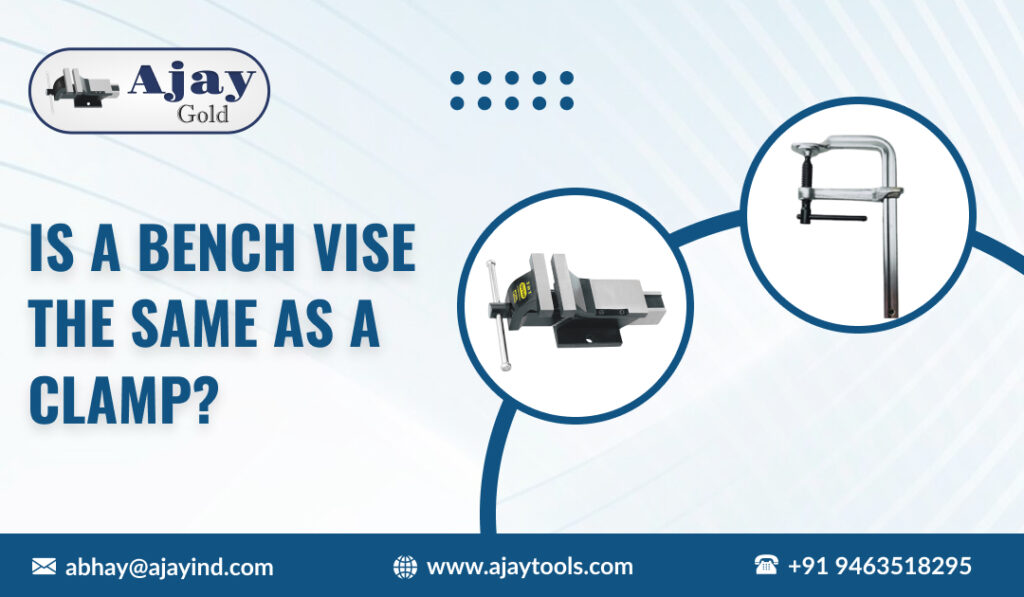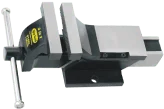Bench vises, whether swivel or fixed, are indispensable parts of any workshop. Their main function is to grip workpieces safely and securely so that they can be worked on. They make work such as chipping, sawing, finishing, sanding, and welding easier by freeing the worker’s hands to perform required tasks. Their versatility means users of any skill level or experience can leverage the power of a bench vise.
Basics of a bench vise and its parts
A bench vise is designed to hold and grip irregularly shaped material to perform different tasks, such as drilling, cutting, filing, or soldering on the held workpiece. They are usually installed on a worktable and consist of jaws – one is fixed, and the other is moveable, which are operated using a screw mechanism. This design makes you able to adjust the bench vice to accommodate irregularly shaped workpieces. Here are bench vise parts along with their functions:
- Moveable jaw can be adjusted using the screw mechanism to provide grip to the material.
- Static jaw remains in a fixed position.
- The slide allows the moveable jaw to move back and forth.
- You can use the handle to rotate the screw mechanism for opening and closing the jaws of a vice.
- The screw allows for the movement of the dynamic or moveable jaw for tightening or releasing the grip on the object.
- The fixed body is the main part of the vice, which provides support to the entire assembly.
- The base is a bottom part of a bench vise, which attaches it to the worktable.
What are clamps used for?
Clamps are versatile tools used to hold and grip material temporarily in place. You can use clamps for various applications such as woodworking, carpentry, welding, furniture making, metalworking, and construction. Different types and sizes of clamps are available on the market.
Is there any difference between a bench vise and a clamp?
Yes, there are some differences between a bench vise and a clamp. Although both are used to grip material in place, a bench vise is a stationary tool installed on a worktable and designed for heavy-duty applications, while a clamp can be moved around to grip the material together in different positions.
- Mobility
A bench vise is installed on a worktable, while a clamp is portable, which means you can move it to different locations.
- Application
You can use a bench vise for heavy-duty tasks, such as drilling, sawing, or filing on a single object. On the other hand, a clamp is a versatile tool used to hold multiple workpieces during gluing or assembly.
- Force application
A bench vise tool applies more clamping force as compared to a clamp, as it is designed to grip an object during heavy-duty tasks.
Essential considerations for purchasing a bench vise
Before buying any hand tool, it’s essential to consider a few things. Here are a few things to consider when buying a bench vise:
- How large workpieces you will be using?
Although vises are available in different sizes, you must consider the size of the object to be clamped and the size of a bench vise. Heavier and larger objects must be held by the heavy-duty bench vises, so choose accordingly.
- Will you be clamping irregularly shaped objects?
To accommodate irregularly shaped workpieces, you may need a swivel base bench vise. If you think you will have to adjust the position of a vise, it would be worth considering a swivel base bench vise tool.
- Will you be using a bench vise every day?
If your tasks involve shaping or hammering, you must consider buying heavy-duty bench vise. You must look for a reputable brand like Ajay Tools when buying the best quality bench vises for everyday use.
Conclusion
It’s essential to understand the difference between a clamp and a bench vise tool. After knowing the difference and their applications, you can choose the right tool for your tasks. No matter whether you are looking for a bench vise or a clamp, you can reach out to Ajay Tools.


